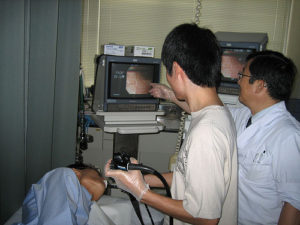 The American Society for Gastrointestinal Endoscopy announced on August 3, 2017 news of promising results for patients who must undergo medical procedures for endoscopic biopsy. Ref. https://www.sciencedaily.com/releases/2017/08/170803152236.htm.
The American Society for Gastrointestinal Endoscopy announced on August 3, 2017 news of promising results for patients who must undergo medical procedures for endoscopic biopsy. Ref. https://www.sciencedaily.com/releases/2017/08/170803152236.htm.
Statistics on Gastrointestinal Problems
The US National Institute of Diabetes and Digestive and Kidney Diseases (NIH) reported in 2009 the number of endoscopies performed were 6.9 million upper, 11.5 million lower, and 228,000 biliary endoscopies. Ref: https://www.ncbi.nlm.nih.gov/pmc/articles/PMC3480553/
The Endoscopy Procedure
An endoscopic medical procedure involves allowing gastroenterologist to inspect the lining of the esophagus, stomach and part of the duodenum using an endoscope, a small, fiber optic device that probes these areas to discover causes of gastrointestinal problem.
During this procedure, human tissue is removed with endoscopic forceps. For physicians performing this procedure, it is considerably tedious and quite stressful.
Once tissue is removed, it is removed to a “fixative vial” and labeled with patient identification, while the patient remains under sedation. From this point, the fixative is removed and the specimen is further inspected to determine if disease or abnormalities are present.
The New Procedure Shows Promise
The new endoscopic procedure is known as “POEM,” a simplified biopsy test that reduces the older procedural steps by utilizing multiple endoscopic biopsy (MB).
In the new procedure, in a single pass of the endoscope up to 25 biopsy specimens can be collected during withdrawal of an endoscope. The specimens are stored in the removable metal tip attached to the endoscope. The metal tip is cut off from the probe tube and sent to a pathology lab for inspection.
The second part of this new procedure also saves time and is more effective. Once the metal tip with the specimens stored inside are sent to the pathology lab, diagnoses are taken from a frozen section of the biopsy specimen.
The specimens may then be microwaved for up to an hour or pathologists may choose the more routine paraffin process which has a duration of four to six hours.
Research Results and Findings
The research team found no appreciable difference in the newer procedure from the older procedure when tested on 15 patients and 125 biopsies. The benefits of the new procedure were found to be cutting edge for endocrinologists.
As stated in the American Society for Gastrointestinal Endoscopy, the new procedure reduced specimen damage, labor involved in taking specimens and less risk of specimen contamination in testing.
Ref: http://www.giejournal.org/issue/S0016-5107(16)X0007-7 (August issue)





